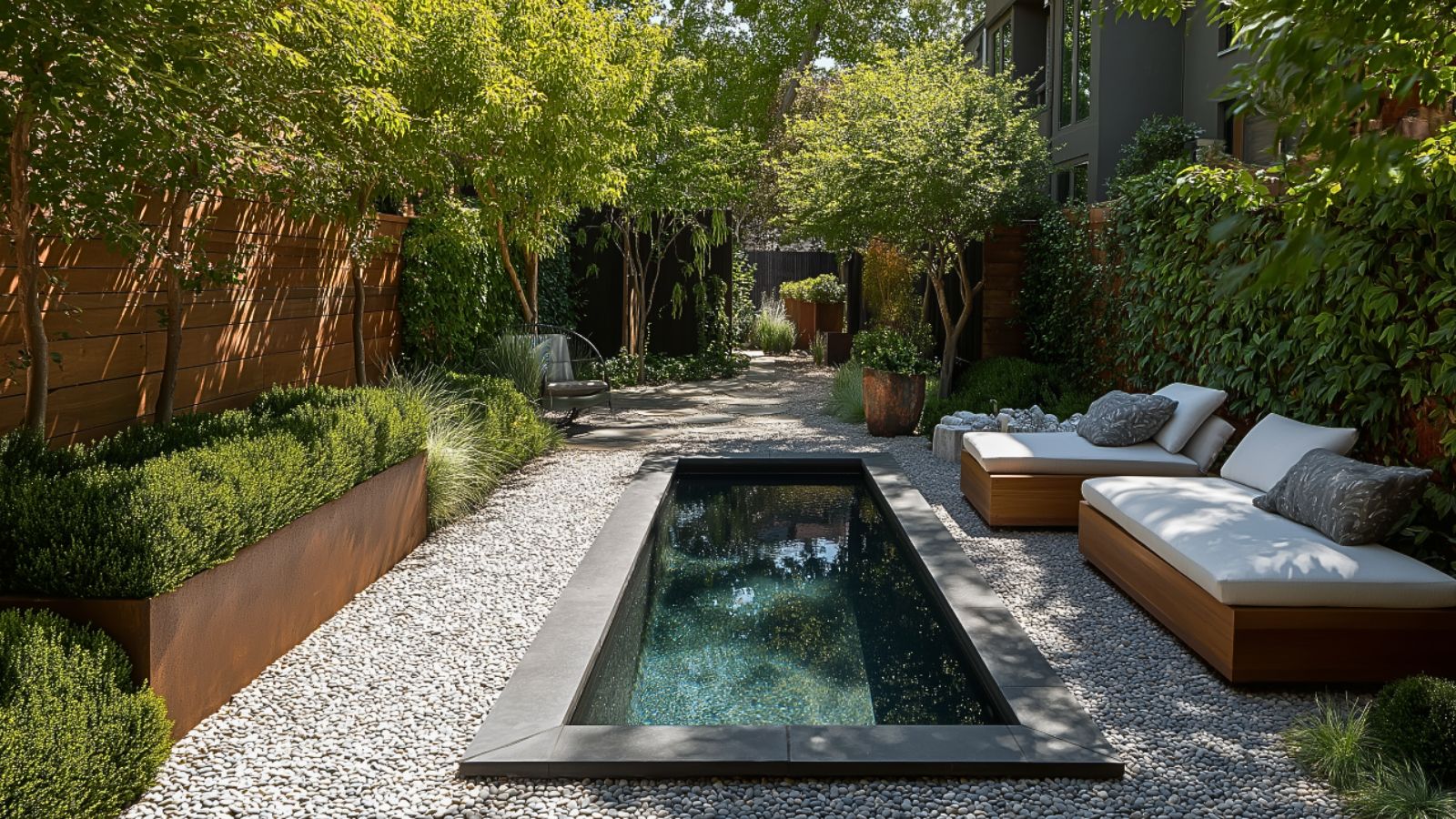DIY Plunge Pool Ideas for Small Spaces: Affordable and Stylish Backyard Solutions
Table of Contents
Dreaming of a backyard pool but tight on space—and budget? You’re not alone. With outdoor living on the rise and the cost of full-size pools soaring, plunge pools have become a favorite alternative for homeowners looking to cool off in compact, stylish ways. In fact, online searches for “small backyard plunge pool” and “DIY plunge pool ideas” have doubled in the last two years, proving that even the tiniest yards can become refreshing retreats.
A plunge pool is a small, shallow pool designed more for lounging than lap-swimming. They offer all the visual appeal and functional enjoyment of a traditional pool, but without the hefty price tag or square footage. And the best part? You can create one yourself with clever planning, the right materials, and a bit of design savvy.
In this guide, we’ll explore DIY plunge pool ideas that are tailor-made for small spaces. From stock tank pools to in-ground solutions, we’ll walk you through affordable approaches, design inspiration, and practical considerations. Whether your outdoor area is a narrow courtyard, a rooftop terrace, or a modest backyard, these plunge pool ideas prove that small-scale can still be seriously stylish.
Why Plunge Pools Are Perfect for Small Spaces
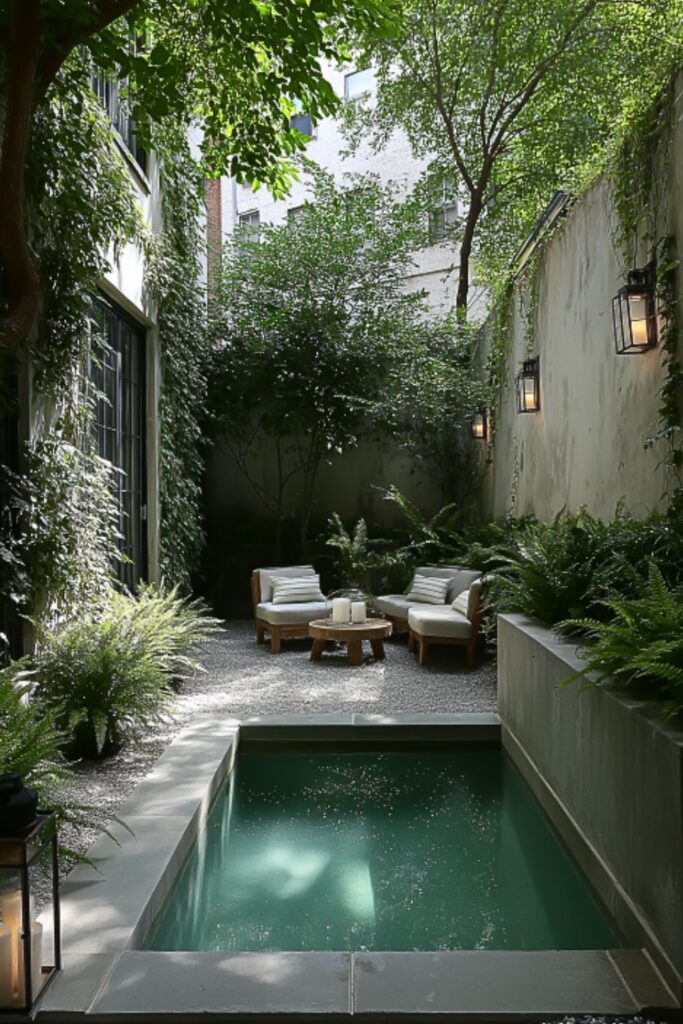
Plunge pools are more than just cute—they’re space-saving, energy-efficient, and increasingly popular for urban and suburban homes alike. Because they require far less room than traditional pools, plunge pools open up the luxury of water features to homeowners who might not have considered it possible.
What makes a plunge pool so ideal for small spaces is its flexibility. You can install it in-ground, semi-inground, or above-ground, depending on your budget, terrain, and aesthetic goals. They also come in a variety of shapes—rectangular, circular, oval—which can be adapted to tight corners or side yards.
Another huge advantage? Maintenance. Plunge pools require fewer chemicals, less electricity, and minimal cleaning effort. They’re also a sustainable option—especially when paired with solar-powered pumps or heaters.
Why Choose a Plunge Pool Table:
| Benefit | Why It Matters for Small Yards |
|---|---|
| Compact Footprint | Fits in patios, corners, and small gardens |
| Energy Efficient | Lower cost to heat and operate |
| Lower Maintenance | Less cleaning and fewer chemicals needed |
| Stylish Versatility | Can be modern, rustic, or naturalistic |
Stock Tank Pools: The Fastest DIY Plunge Solution
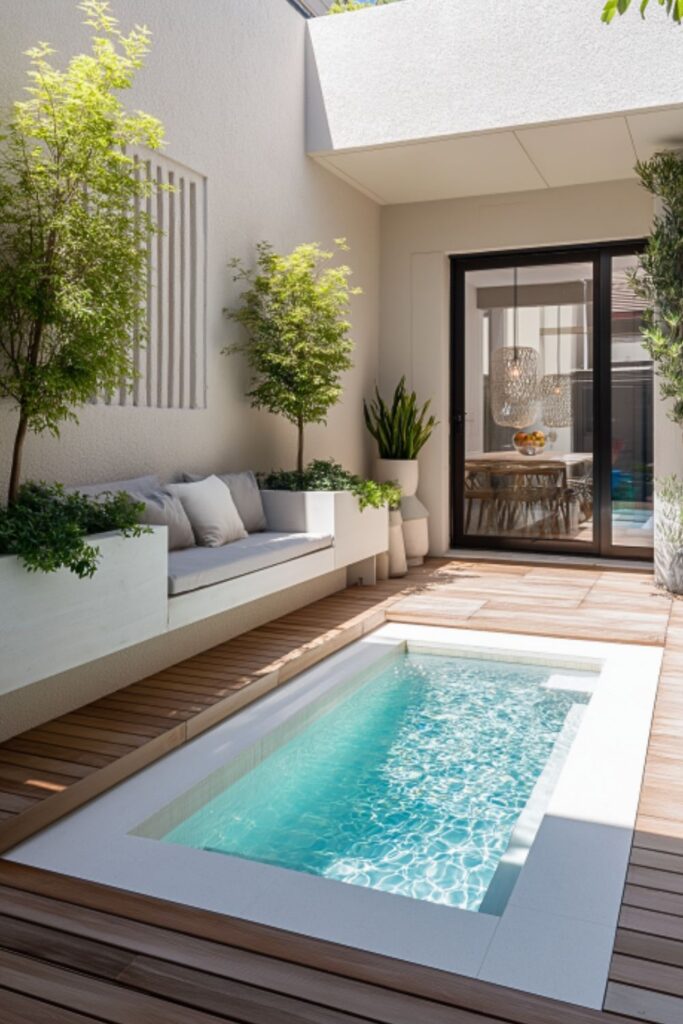
If you’re looking for the quickest, cheapest, and trendiest way to install a plunge pool, a stock tank pool is your answer. Originally designed as watering troughs for livestock, stock tanks have become backyard darlings thanks to their affordability, simplicity, and rustic charm.
Available in galvanized steel or heavy-duty plastic, these tanks come in various sizes—most commonly 6 to 8 feet in diameter and about 2 feet deep. That’s the perfect plunge depth for cooling off without needing extensive excavation or infrastructure.
Installation is surprisingly simple. Choose a level surface (concrete pads or gravel work best), position your tank, and connect a small pump and filtration system. Want to add a heater? Solar covers or propane heaters can be easily integrated.
To give your stock tank plunge pool a designer look, surround it with a wood deck, install LED lighting, or add climbing plants and tropical greenery. Some DIYers even paint the outside or clad it in tile or wood slats for a custom finish.
Stock Tank Pool Checklist:
| Step | What You’ll Need | Pro Tip |
|---|---|---|
| Choose Your Tank | Steel or plastic, 6–8 ft wide | Look for rust-resistant coatings |
| Prep the Surface | Gravel, concrete slab, or pavers | Ensure it’s level for water balance |
| Install Filtration | Pool pump, filter, chlorine floater | Small pond pumps can also work |
| Add Personal Touches | Decking, paint, plants | Use vertical gardens for privacy |
Semi-Inground Plunge Pools for a Sleek Look
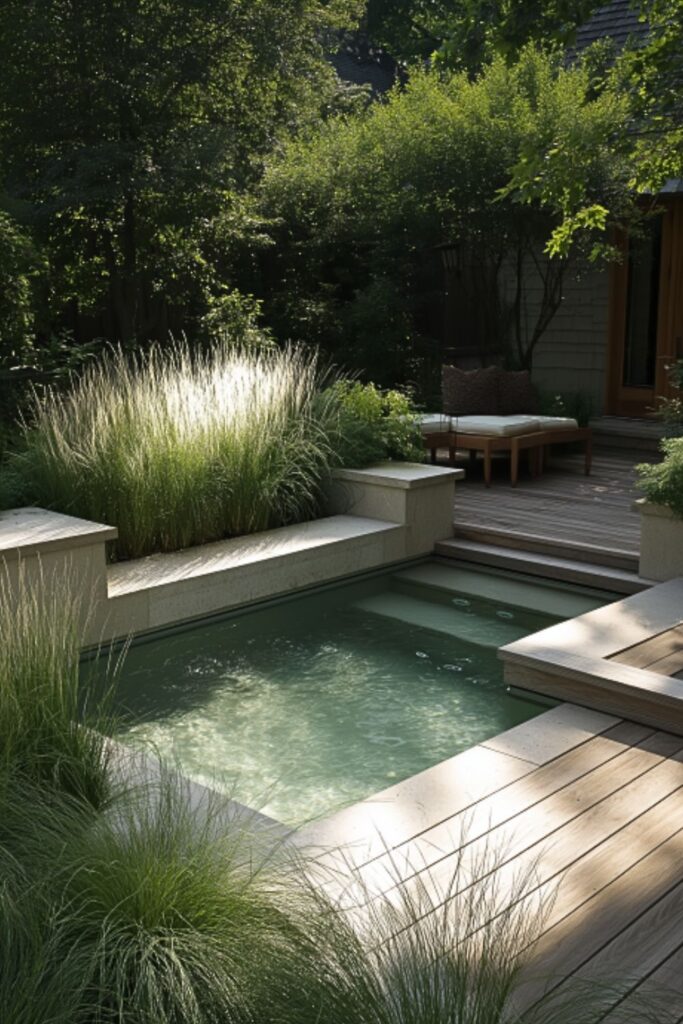
If you love the visual appeal of an in-ground pool but want to avoid the high cost and excavation, consider a semi-inground plunge pool. These pools are partially buried into the landscape, blending effortlessly with garden features while offering more structural stability than an above-ground option.
Materials for semi-inground pools range from precast concrete to modular fiberglass shells. Their design can follow the contours of your space, and the raised edges can double as built-in seating or plant platforms.
One of the biggest design benefits? You can surround the pool with decking, gravel, or pavers for a custom look. Because the pool rises above ground slightly, it also allows for more creative landscaping—think cascading plants, pergolas, or accent lighting built into the retaining walls.
This option tends to cost more than a stock tank but less than a fully in-ground pool, offering a sweet spot between DIY accessibility and polished aesthetics.
Semi-Inground Design Table:
| Feature | Style & Function |
|---|---|
| Raised Edges | Doubles as seating and helps define the space |
| Deck Integration | Seamlessly joins pool to patio or yard |
| Custom Finishes | Tile, stone veneer, or wood slats |
| Landscaping Enhancements | Surround with grasses, rocks, or lighting |
Precast Concrete Plunge Pools: Compact and Customizable
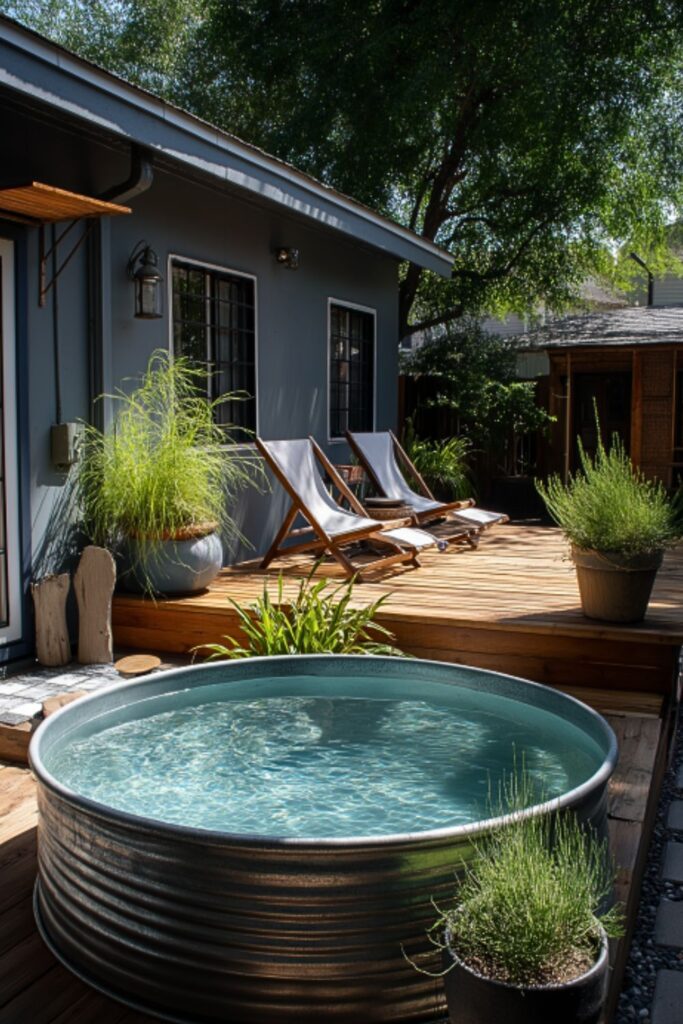
For homeowners seeking durability and a high-end look, precast concrete plunge pools offer an ideal DIY-friendly solution. These prefabricated pools are cast off-site and delivered ready to install. While they require some heavy lifting and planning, they eliminate the weeks-long build time of traditional pools and are ideal for smaller yards with access for machinery.
One of the biggest benefits of precast pools is their longevity. Concrete is strong, weather-resistant, and can be finished in a variety of ways—from smooth plaster to mosaic tile interiors. Many manufacturers also offer insulation options, which help retain heat and improve energy efficiency.
While not cheap, precast plunge pools are cost-effective compared to custom concrete installations. They’re also available in compact sizes, typically starting around 6 feet by 10 feet, making them perfect for urban courtyards or narrow side yards.
Installation usually involves excavation, preparing a level gravel or concrete base, craning in the unit, and then hooking up plumbing and electrical components. You can DIY the landscaping and finishes, such as surrounding decking or fencing, to personalize the final result.
Precast Plunge Pool Overview:
| Feature | Benefit |
|---|---|
| Prefabricated Shell | Fast install, fewer construction delays |
| Compact Sizes | Ideal for small yards and tight access |
| Custom Finishes | Smooth plaster, pebble tech, or tile options |
| Long-Term Durability | Withstands weather and daily use |
Creative Above-Ground Pool Ideas That Don’t Look Cheap
Many homeowners hesitate to go above-ground fearing it may look out of place or unsophisticated. But with thoughtful design, above-ground plunge pools can be every bit as chic as their in-ground counterparts.
Framing the pool is key. Build a custom wood platform or deck around the base to give it a more integrated look. Surround with raised planters, fencing, or bench seating for privacy and polish.
Circular plunge tubs, similar to Japanese-style soaking tubs, also fall under this category. These offer deep soaking comfort and take up very little square footage. Clad the exterior in cedar or hardwood slats for a spa-like vibe.
Color coordination also plays a huge role. Matching the pool’s finish to your patio or exterior wall color helps the whole space feel cohesive and intentional.
Stylish Above-Ground Pool Tips:
| Element | Style Enhancement |
|---|---|
| Custom Decking | Makes pool feel like part of the yard |
| Wood or Tile Cladding | Adds texture and visual interest |
| Planter Integration | Softens edges and improves privacy |
| Consistent Color Palette | Unifies the look with surrounding space |
Small Space Layout Tips for Plunge Pool Placement
Placing your plunge pool correctly is as important as choosing the right type. In small yards, every inch matters, so careful layout planning will enhance both function and flow.
Start by evaluating sun exposure. Position your pool where it gets natural light during the warmest part of the day—it will help with passive heating and make the space more inviting.
Consider the view from inside your home. A plunge pool can act as a water feature when placed near windows or patios. Align it with sightlines for added visual impact.
Accessibility is also crucial. Make sure there’s room to comfortably walk around the pool, and keep key utilities (electrical, plumbing) easily accessible for maintenance.
Use landscaping elements like hedges, privacy screens, or trellises to create visual boundaries without overwhelming the space. Vertical gardening is a great way to add greenery while conserving floor area.
Layout Strategy Table:
| Consideration | Design Tip |
|---|---|
| Sunlight | Orient for max afternoon exposure |
| Visual Connection | Align with interior sightlines |
| Walkway Clearance | Leave 2–3 feet around pool perimeter if possible |
| Privacy | Use slim hedges or vertical screens |
Conclusion
With a little creativity and the right planning, even the smallest yard can host a stunning plunge pool that delivers both style and refreshment. Whether you choose a quick stock tank, a sleek semi-inground build, or a sophisticated precast design, the key is to blend functionality with design-forward thinking. Small spaces don’t mean small dreams—they just invite smarter solutions. Let your outdoor area reflect your taste and lifestyle, and enjoy the luxury of a personal retreat that fits perfectly into your home.

